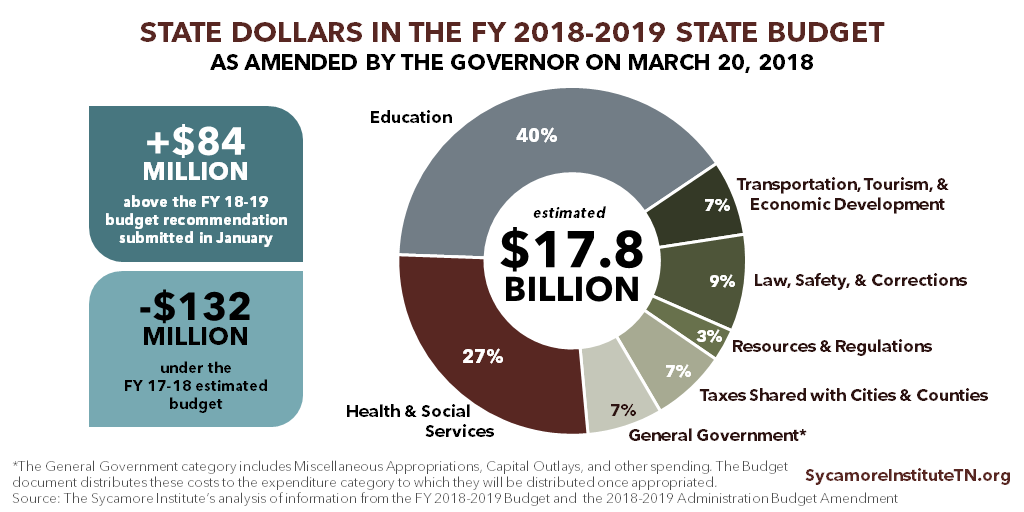Last week, Governor Haslam proposed his amended budget proposal for the fiscal year that begins on July 1, 2018. The revised plan makes changes and updates to the original recommended budget the governor proposed in January. These changes reflect new information that the administration has about revenue collections, program needs, and legislative action. The “administration amendment” marks one of the final steps in the process to get next year’s budget approved by the legislature (which will likely be one of the General Assembly’s final actions before adjourning for the year).
Topline Numbers
The revised FY 2018-2019 recommended budget would spend $17.8 billion from state revenues. This is approximately $84 million (or 0.5%) more than the original recommendation and -$132 million (or -0.7%) less than estimates for the current fiscal year. Overall, these changes are relatively modest in the context of the overall budget and compared to amended budget recommendations in prior years.
The Amendment’s Expenditure Increases
The governor’s budget amendment increases expenditures by $84 million relative to the recommendation submitted in January – including $9.8 million in recurring state dollars and $74.7 million in non-recurring spending.
The largest expenditure increase is $30.2 million for a new school safety initiative – including $5.2 million in recurring funds and $25.0 in non-recurring spending. The initiative is largely funded by a transfer from the reserve of funds from handgun permit fees. The recurring funds would be combined with $4.8 million in recurring funds already in the governor’s budget recommendation for ongoing school safety grants.
Governor Haslam’s recently-appointed school safety working group released a set of priorities on March 26th that would be supported with school safety funding request, if approved. These include a risk assessment for all schools, additional dollars for school resource officers (SROs), and a statewide app for anonymously reporting security threats.
The Amendment’s Changes for Opioid Epidemic Efforts
The administration amendment includes a total of $3.7 million in additional spending to support the state’s response to the opioid epidemic. The budget recommendation submitted in January included a total of $14.5 million for the governor’s TN Together initiative. Changes in the amendment include:
- $2.0 million in non-recurring spending for the Center for Addiction Science at the UT Health Science Center in Memphis. The Center trains physicians and health professionals in preventing, diagnosing, and treating addiction.
- +$1.0 million in additional recurring spending to expand TDMHSAS’ safety net treatment capacity — for a total increase of $9.3 million in recurring dollars for expanded treatment in FY 2018-2019.
- $0.7 million for a senior judge ($0.3 million non-recurring) and 4 assistant district attorneys ($0.5 million recurring) for recovery courts.
The Amendment’s Increases for Health & Social Services
Under the revised FY 2018-2019 budget, state dollars for health and social services exceed $4.8 billion. The amendment includes a total of $11.6 million in additional spending within this total, including:
- $4.5 million in new recurring spending for community programs within TDMHSAS that support pending juvenile justice reforms.
- $3.2 million in additional recurring dollars for payment rate increases for state-contracted intellectual/developmental disability service providers. This more than doubles the $1.8 million in recurring increases included in the budget recommendation for the same purpose. Together, these funds will likely trigger about $9.7 million in additional federal Medicaid match dollars to increase provider rates.
- $1.6 million in additional funds for Adverse Childhood Experiences(ACEs) Prevention Grants. When combined with the January recommendation, the FY 2018-2019 amended budget includes a total of $2.5 million in recurring funds and $0.4 million in non-recurring spending for ACEs. These activities have been funded at $1.3 million on a non-recurring basis since FY 2016-2017.
- $1.0 million in non-recurring funding for TDMHSAS for 3 East Tennessee psychiatric hospitals.
- +$1.0 million in additional recurring spending to expand safety net drug treatment capacity (explained above).
- $0.3 million in recurring spending for Centerstone Military Services, which provides counseling services to veterans and their families suffering from post-traumatic stress disorder. This activity was funding at $0.4 million for the current fiscal year.
The Amendment’s Changes to FY 2018-2019 Revenues
The vast majority of the amendment’s spending increases are funded by an additional $74 million in what is expected to roll over from the current fiscal year as a non-recurring revenue source. January’s budget recommendation estimated that about $445 million would be available at the end of the current fiscal year. The additional balances in the amendment primarily come from program underspending ($45.0 million), additional revenues not previously budgeted ($19.4 million), and a transfer from the reserve of funds from handgun permit fees ($10.0 million).
What Happens Next?
Over the next few weeks, the Tennessee House and Senate Finance Committees will make their own incremental changes to the budget based on amendments and legislation proposed by legislative committees and individual legislators. The legislature is expected to pass the budget in early to mid-April and adjourn shortly after.
Key FY 2018-2019 Budget Documents
- Budget Recommendation (January 2018)
- Budget Recommendation: Volume 2 – Base Budget Reductions (January 2018)
- Budget Recommendation Overview Recommendation (January 2018)
- Budget Recommendation Presentation (January 2018)
- Administration Amendment Overview (March 2018)
- Administration Amendment Presentation (March 2018)
Related Work by The Sycamore Institute
The Budget in Brief: Summary of Gov. Haslam’s FY 2018-2019 Recommended Budget
(February 2, 2018) A summary of the governor’s January budget recommendation submission to the legislature.
Tennessee State Budget Primer
(updated November 2017) A comprehensive overview of the state budget process.

